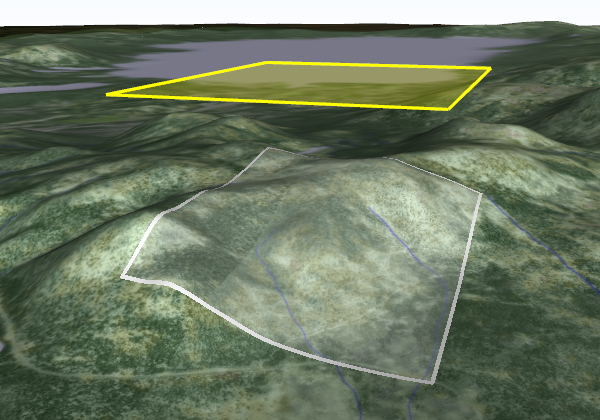SurfaceOverlay Class
Specifies parameters and layers to render as overlays on the ground mesh of a GlobeView.
NuGet/Assembly: Carmenta.Engine.5.17.0.nupkg (in the CECore assembly)
Syntax
public class SurfaceOverlay : OverlayRemarks
There is a 3D sample 3d_surface_overlay.px that demonstrates how to use the SurfaceOverlay in a GlobeView to show the footprint of 3D objects.
When an instance of this class is assigned to the GlobeView.SurfaceOverlay property, the GlobeView will render the Layers onto internal bitmaps, and overlay these bitmaps on the ground mesh and all meshes read from GlobeView.AuxiliaryGroundInput.
Unlike the GlobeView.SurfaceLayers which are only read and rendered to a bitmap once, the overlay bitmaps are re-rendered every frame, and are therefore capable of displaying dynamic application objects. A typical use case is to display footprints on the ground of 3D objects in the air, to give the viewer a better understanding of the location of the 3D objects.
 |
The bitmap or bitmaps are positioned around the current camera position. The value of the TextureSize property determines the size of the bitmaps in pixels; the bigger bitmaps, the better the resolution will be. The default value will give a little better resolution than the usual surface texture, which should work well for rendering vector data.
But since the size of the textures is limited, so is the range. When an object moves too far away from the camera, it will disappear. To improve the range, more than one bitmap can be used, by setting the LevelsOfDetail property. Each additional bitmap will add another level of detail, which will be rendered at half the resolution, but will approximately double the range.
Using this function will affect resource usage and rendering performance. Increasing texture size will use up more video memory, but not affect performance so much. Increasing the number of levels will also use more memory, plus increase both GPU and CPU load. The most important factor is probably the number of rendered objects, read from Layers. To maintain a reasonable performance, you should only use this function for a limited number of objects.
Also note Dynamic is supported for any OrdinaryLayer in Layers. Use this if possible to get the best possible performance.
Inheritance Hierarchy
System.Object
EngineObject
Overlay
SurfaceOverlay
Platforms
Windows, Linux, Android
SurfaceOverlay Members
The SurfaceOverlay type has the following members.
Constructors
| Name | Description |
|---|---|
| SurfaceOverlay | Initializes a new instance of the SurfaceOverlay class. |
Properties
| Name | Description |
|---|---|
| Antialias | Gets or sets a flag indicating if antialiasing should be used to remove aliasing artifacts by smoothing the pixels. |
| Condition | Gets or sets a condition that determines whether the overlay is drawn or not. Inherited from Overlay |
| Enabled | Gets or sets a flag determining whether the overlay is drawn or not. Inherited from Overlay |
| IsDisposed | Gets a value that tells whether the current SurfaceOverlay has been disposed. Inherited from EngineObject |
| Layers | Gets the collection of 2D layers that should be rendered as an overlay on the ground mesh. |
| LevelsOfDetail | Gets or sets the number of levels of detail used for the surface overlay. |
| Name | Gets or sets the name of the overlay. Inherited from Overlay |
| NativeHandle | Gets the native Carmenta Engine kernel object the current SurfaceOverlay represents. Inherited from EngineObject |
| TextureSize | Gets or sets the size in pixels of the bitmaps used to render each level of detail of the surface overlay. |
| IUserProperties.UserProperties | Gets the AttributeSet that contains the user properties. Inherited from IUserProperties |
Methods
| Name | Description |
|---|---|
| Clone | Creates a copy of an object. Inherited from EngineObject |
| Dispose | Releases the reference to the native Carmenta Engine kernel instance the EngineObject represents. Inherited from EngineObject |
| Equals | Determines whether this instance is equal to another. Inherited from EngineObject |